

Watney
Market
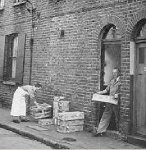
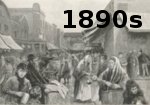


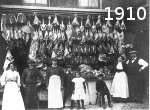
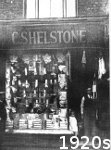 In the early years
of the 20th century the shops and stalls of Watney Street [the southern end of which was formerly Charles Street], making up Watney Market,
was one of the liveliest local markets in London: in 1902 there were
over 100 shops and 100 stalls (so this 1902 claim that it was in decline is curious). Left are
some images from that period. At no.68 there was an early branch
of
Sainsbury's (their first shop, in Drury Lane, opened in 1869): in 1881
John James Sainsbury took over his brother-in-law Edward Staples' shop
selling cheese and salt bacon to dockers and lightermen, many of them
Irish (Mary Ann Staples, whose family had built up a chain of shops,
married John James Sainsbury in 1869). They were in competition with
Mike Drummond, a popular Irish
shopkeeper at no.67, and (as later recalled by J.J.'s son John
Benjamin) employed a jocular character called Husk to invite passers-by
to try out their butter and other products. They bought a house behind
the shop, at 21 Morris Street [now an open space above the London Overground lines - which run underground at this point!] to conceal their deliveries [right] - perhaps the first example of rear deliveries. When Mike Drummond retired in 1894, the Sainsburys bought his shop.
In the early years
of the 20th century the shops and stalls of Watney Street [the southern end of which was formerly Charles Street], making up Watney Market,
was one of the liveliest local markets in London: in 1902 there were
over 100 shops and 100 stalls (so this 1902 claim that it was in decline is curious). Left are
some images from that period. At no.68 there was an early branch
of
Sainsbury's (their first shop, in Drury Lane, opened in 1869): in 1881
John James Sainsbury took over his brother-in-law Edward Staples' shop
selling cheese and salt bacon to dockers and lightermen, many of them
Irish (Mary Ann Staples, whose family had built up a chain of shops,
married John James Sainsbury in 1869). They were in competition with
Mike Drummond, a popular Irish
shopkeeper at no.67, and (as later recalled by J.J.'s son John
Benjamin) employed a jocular character called Husk to invite passers-by
to try out their butter and other products. They bought a house behind
the shop, at 21 Morris Street [now an open space above the London Overground lines - which run underground at this point!] to conceal their deliveries [right] - perhaps the first example of rear deliveries. When Mike Drummond retired in 1894, the Sainsburys bought his shop.
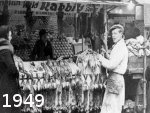
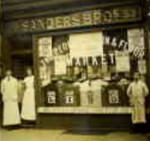 Left is one of the several shops of Ernest Albert and Emily Sanders at 53 Watney Street. By
1928 the number of stalls had more than doubled, and Christ Church
Watney Street joined with other local churches in
opposing the
renewal of licences for shops and stalls, because they were trading
on Sundays. This was an issue for churches elsewhere in the parish -
see here.
But despite the illegality, licences continued to be issued. A
compromise was attempted with the Shops (Sunday Trading Restriction)
Act 1936 - superseded by the 1950 Shops Act - but this proved broadly
unenforceable in heavily Jewish areas. [Right is Johnny Philipps'
rabbit stall in 1949].
Left is one of the several shops of Ernest Albert and Emily Sanders at 53 Watney Street. By
1928 the number of stalls had more than doubled, and Christ Church
Watney Street joined with other local churches in
opposing the
renewal of licences for shops and stalls, because they were trading
on Sundays. This was an issue for churches elsewhere in the parish -
see here.
But despite the illegality, licences continued to be issued. A
compromise was attempted with the Shops (Sunday Trading Restriction)
Act 1936 - superseded by the 1950 Shops Act - but this proved broadly
unenforceable in heavily Jewish areas. [Right is Johnny Philipps'
rabbit stall in 1949].
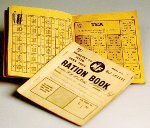 In
1939 the Ministry of Food required people to register for rationing
(committing them to use a particular shop); the paperwork was complex,
and William Guest, manager of Sainsbury's in Watney Street, was
inundated with customers who were unable to cope with it. He consulted
the district supervisor, who referred it to the head office at
Blackfriars; next day, Miss Potter and a group of clerical staff
arrived by taxi, took several thousand ration books away and returned
them the next day immaculately completed and with a complete card index
system.
Watney Street suffered
in the
blitz; an unexploded bomb fell on the Maypole Dairy next door to
Sainsbury's, who traded from a street stall for a time. (See more in
the Sainsbury's archive.)
In
1939 the Ministry of Food required people to register for rationing
(committing them to use a particular shop); the paperwork was complex,
and William Guest, manager of Sainsbury's in Watney Street, was
inundated with customers who were unable to cope with it. He consulted
the district supervisor, who referred it to the head office at
Blackfriars; next day, Miss Potter and a group of clerical staff
arrived by taxi, took several thousand ration books away and returned
them the next day immaculately completed and with a complete card index
system.
Watney Street suffered
in the
blitz; an unexploded bomb fell on the Maypole Dairy next door to
Sainsbury's, who traded from a street stall for a time. (See more in
the Sainsbury's archive.)
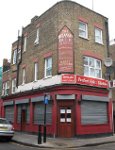 In 1956 the Watney Streeters
- most of them dockers, descendants of an earlier Watney Street gang
who defended their patch against rivals from Bethnal Green - were
involved in brawls with the Kray twins and their associates. 'Their' pub was the Britannia,
at 44 Morris Street (run by Watney's - the name is coincidental), a few yards behind Watney
Street: here Ronnie Kray bayonet-stabbed Terry Martin, a member of the
gang, while the rest escaped through the back door. In retaliation they
beat up
Billy Jones, who ran a West End club, which in turn led to one of their
leaders, Charlie, being 'worked over' by Bobby Ramsey at The Artichoke in
Stepney Way (more details here). The Britannia was acquired by Belhaven in 1991 and closed in 2005; it now houses a fast food outlet, but the sign remains [left].
In 1956 the Watney Streeters
- most of them dockers, descendants of an earlier Watney Street gang
who defended their patch against rivals from Bethnal Green - were
involved in brawls with the Kray twins and their associates. 'Their' pub was the Britannia,
at 44 Morris Street (run by Watney's - the name is coincidental), a few yards behind Watney
Street: here Ronnie Kray bayonet-stabbed Terry Martin, a member of the
gang, while the rest escaped through the back door. In retaliation they
beat up
Billy Jones, who ran a West End club, which in turn led to one of their
leaders, Charlie, being 'worked over' by Bobby Ramsey at The Artichoke in
Stepney Way (more details here). The Britannia was acquired by Belhaven in 1991 and closed in 2005; it now houses a fast food outlet, but the sign remains [left].
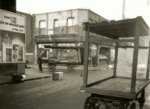 Mandy Brock's family
history site describes the daily routine of her grandfather Frederick
Cornelius Lyons (1903-65) which was no doubt typical of that of other
traders in the street. Freddie started helping his mother Sally on
the family fruit and vegetable stalls from the age of 11. When he was in
charge, he rose at 3am to go to the wholesale market in Spitalfields
and order the day's produce, only paying on delivery if it was up to
standard (if not, he'd expect a re-delivery). Then he wheeled the
loaded stalls to their spot (outside Rosen's - third image from left above),
where his brother George would oversee of the day's selling. After a
wash, a meal and a nap Freddie returned to the stall, returning it at
the day's end to the shed under the Watney Street railway arches [right] -
right up to the day he suffered a fatal heart attack. (All the family
baptisms and weddings were at Christ Church Watney
Street, or St John Grove Street, or other local churches; his daughter
Jean Baldry and her family emigrated to Canada in 1968.) Mandy Brock's family
history site describes the daily routine of her grandfather Frederick
Cornelius Lyons (1903-65) which was no doubt typical of that of other
traders in the street. Freddie started helping his mother Sally on
the family fruit and vegetable stalls from the age of 11. When he was in
charge, he rose at 3am to go to the wholesale market in Spitalfields
and order the day's produce, only paying on delivery if it was up to
standard (if not, he'd expect a re-delivery). Then he wheeled the
loaded stalls to their spot (outside Rosen's - third image from left above),
where his brother George would oversee of the day's selling. After a
wash, a meal and a nap Freddie returned to the stall, returning it at
the day's end to the shed under the Watney Street railway arches [right] -
right up to the day he suffered a fatal heart attack. (All the family
baptisms and weddings were at Christ Church Watney
Street, or St John Grove Street, or other local churches; his daughter
Jean Baldry and her family emigrated to Canada in 1968.) |
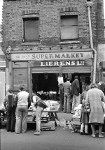
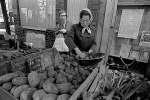
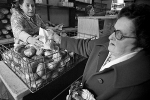 Here are some of a set of pictures from 1973-78 by Tony Bock. Born in
London and brought up in Canada, he came back to London and worked as a
photographer on the East London Advertiser from 1973-78 before returning to Canada where he was a photojournalist for 30 years on the Toronto Star. The
first shows Alf 'Dutchie' Lierens shop in its last days (remembered by
his grandson David); the second Eileen Armstrong (who it's said was
always smartly dressed in tailored coat and headscarf); the third Pat
Crosher serving in a bakery.
Here are some of a set of pictures from 1973-78 by Tony Bock. Born in
London and brought up in Canada, he came back to London and worked as a
photographer on the East London Advertiser from 1973-78 before returning to Canada where he was a photojournalist for 30 years on the Toronto Star. The
first shows Alf 'Dutchie' Lierens shop in its last days (remembered by
his grandson David); the second Eileen Armstrong (who it's said was
always smartly dressed in tailored coat and headscarf); the third Pat
Crosher serving in a bakery.
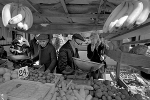
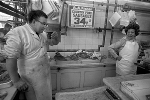
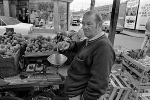
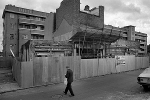
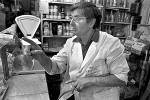
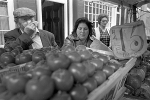 Right is Joe the grocer, and the demolition of his shop.
Right is Joe the grocer, and the demolition of his shop.
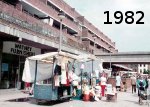
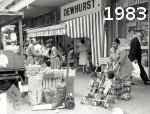
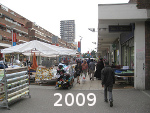
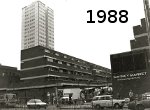 Sites
were cleared
for redevelopment -
housing and a new market - but it was slow in coming. Sainsbury's
- by then on the corner of Commercial Road - moved to Cambridge Heath
Road (their Watney Street site is now occupied by Iceland). By
1979 there were only eighteen stalls left.
Sites
were cleared
for redevelopment -
housing and a new market - but it was slow in coming. Sainsbury's
- by then on the corner of Commercial Road - moved to Cambridge Heath
Road (their Watney Street site is now occupied by Iceland). By
1979 there were only eighteen stalls left.
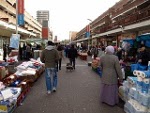
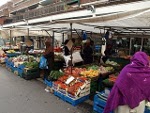
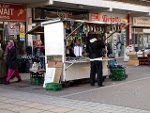
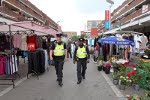
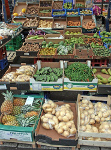
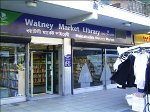 Twenty
years on, the rebuilding is now more or less finished, and the area has
been expensively landscaped, but much of its character has gone.
Twenty
years on, the rebuilding is now more or less finished, and the area has
been expensively landscaped, but much of its character has gone.  Tower Hamlets Council has plans to regenerate the market,
increasing the number of stalls and making them more attractive,
widening the range of goods on sale and catering facilities, both for
local people and as a 'venue' for those who work nearby or who will be passing through now that the East London line
has re-opened as part of London Overground in June 2010; they have also added
a neighbourhood Idea Store.
Tower Hamlets Council has plans to regenerate the market,
increasing the number of stalls and making them more attractive,
widening the range of goods on sale and catering facilities, both for
local people and as a 'venue' for those who work nearby or who will be passing through now that the East London line
has re-opened as part of London Overground in June 2010; they have also added
a neighbourhood Idea Store.
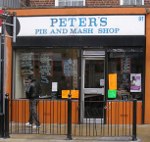

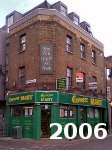 At the southern end of Watney Street was The Old House at Home
pub at no.87, on the corner of Cornwall Street; when it closed, it
became a Polish deli, with flats above, and is now Asian-run but with
some Polish products. Next door was Peter's Pie and Mash shop (see various sites which describe the parsley-flavoured 'liquor' - far right): it closed in 2011 when Peter retired.The only pub now in Watney Street is the modern Thomas Neale Free House at no.39.
At the southern end of Watney Street was The Old House at Home
pub at no.87, on the corner of Cornwall Street; when it closed, it
became a Polish deli, with flats above, and is now Asian-run but with
some Polish products. Next door was Peter's Pie and Mash shop (see various sites which describe the parsley-flavoured 'liquor' - far right): it closed in 2011 when Peter retired.The only pub now in Watney Street is the modern Thomas Neale Free House at no.39.